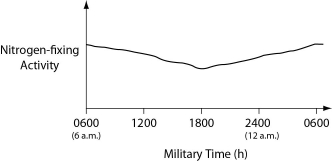Multiple Choice
The data were collected from the heterocysts of a nitrogen-fixing cyanobacterium inhabiting equatorial ponds. Study the graph in Figure 24.3 and choose the most likely explanation for the shape of the curve.  Figure 24.3
Figure 24.3
A) Enough O2 enters heterocysts during hours of peak photosynthesis to have a somewhat-inhibitory effect on nitrogen fixation.
B) Light-dependent reaction rates must be highest between 1800 hours and 0600 hours.
C) Atmospheric N2 levels increase at night because plants are no longer metabolizing this gas, so they are not absorbing this gas through their stomata.
D) Heterocyst walls become less permeable to N2 influx during darkness.
E) The amount of fixed nitrogen that is dissolved in the pond water in which the cyanobacteria are growing peaks at the close of the photosynthetic day (1800 hours) .
Correct Answer:

Verified
Correct Answer:
Verified
Q2: Regarding prokaryotic genetics, which statement is correct?<br>A)
Q12: Chloramphenicol is an antibiotic that targets prokaryotic
Q30: The following table depicts characteristics of five
Q47: The typical prokaryotic flagellum features<br>A) an internal
Q49: How were conditions on the early Earth
Q56: Use the information in the following paragraph
Q60: Match the numbered terms to the description
Q64: If it were possible to conduct sophisticated
Q72: If a bacterium regenerates from an endospore
Q78: Figure 27.2 depicts changes to the amount